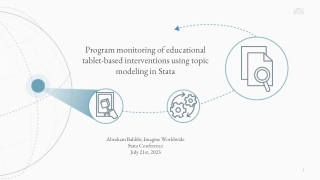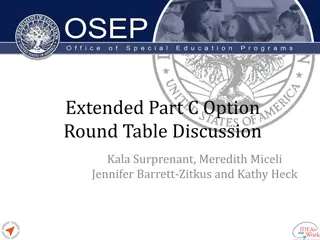Insights into Transcription: Mediator Identification and RNAPII Structure Study
The images and text provide a detailed account of how the mediator was identified and the analysis of RNAPII structure through in vitro chromatin assembly, genetic screens, and mass spectrometry. The process of mediating activation in transcription and the complex purification steps involved in studying RNAPII subunit composition are highlighted.
Download Presentation

Please find below an Image/Link to download the presentation.
The content on the website is provided AS IS for your information and personal use only. It may not be sold, licensed, or shared on other websites without obtaining consent from the author. Download presentation by click this link. If you encounter any issues during the download, it is possible that the publisher has removed the file from their server.
E N D
Presentation Transcript
MCB 317 Genetics and Genomics MCB 317 Topic 10, part 5 A Story of Transcription
In vitrochromatin Assembly Purify Polymerases Genetic Screens Histone Biochemistry Immuno-affinity Purification, Mass Spec In vitro txn of in vitro chromatin Coactivators Mediator Activators Chromatin Remodeling Complexes
RNAPs Purified Based on in vivo txn of naked genomic DNA- nonpecific synthesis of RNA, but is the structure (subunit composition) of RNAPII the same in vivo as defined in vitro?
Hypothesis: Steps involved in purification of RNAPs may have dissociated some subunits. Test: Purify RNAPII by the most gentle method possible Method: Immunoaffinity purification and Immunoprecipitation from crude extracts
Affinity purification of RNAPII identified mediator (as did a genetic screen) Lodish 11-35
Mass Spectrometer Two spectrometers working in tandem 1. Separate large fragments of proteins 2. Those fragments analyzed by a second spectrometer -> masses of peptides 3. Masses of peptides = sequence of peptide fragments 4. Computer compares sequence of peptide fragments with predicted products of genes in genome to identify the gene that encodes the protein
One Subunit -> Complex Protein -> Immuno-affinity purification -> mass spec -> genome database -> genes that encode subunits of a complex
1 Protein Complex Protein Subunit 2 Genes (encoding) other subunits 1. Immuno-affinity purification 2. Mass-spec and genomic database search
Biochemistry Subunits of Protein Complex 1 Protein Orthologs and Paralogs 2 6 9 5 4 Gene Ab 7 3 8 Expression Pattern Mutant Gene 10 Mutant Organism 11 Genetics
Biochemistry Subunits of Protein Complex 1 12 Protein Orthologs and Paralogs 13 2 6 9 5 4 Gene Ab 7 3 8 Expression Pattern Mutant Gene 10 Mutant Organism 11 Genetics
Yeast Genome Manipulation via Homologous Recombination Gene disruption Determine null phenotype of a gene Gene replacement Create mutant alleles of a gene [pt mut, deletion series, etc] Epitope TAG GFP fusions and protein localization
Gene Deletion in Yeast by Homologous Recombination Marker Gene
Yeast Gene Disruption YFG in yeast chromosome: UAS Pr YFG URA3 on plasmid: UAS Pr URA3 PCR UAS Pr URA3
Yeast Gene Disruption Transform PCR Product into yeast Select for URA3 UASURA3 PrU URA3 UASYFG PrY YFG UASYFG PrY UASURA3 PrU URA3
Gene Disruption in Yeast 1. Delete one copy of YFG in a diploid strain 2. Sporulate, dissect tetrads. 3. If your gene is essential, only two spores will form colonies; if it is not essential all four will form colonies 4. Compare null phenotype to phenotype of your alleles
Biochemistry Subunits of Protein Complex 1 12 Protein Orthologs and Paralogs 13 2 6 9 5 4 Gene Ab 7 3 8 Expression Pattern Mutant Gene 10 Mutant Organism 11 Genetics
Gene Replacement Replace Chromosomal at Native Locus YFG yfg
Gene Replacement by Counterselection URA3 Ura3 X Y Uracil
5 FOA is an analog of the Substrate of the Ura3 Enzyme URA3 Ura3 5 FOA Toxic Product URA3 cells dead on media containing 5-FOA ura3 cells alive on media containing 5-FOA
Gene Replacement Replace Chromosomal at Native Locus YFG Replace YFG with URA3 URA3 Transform with mutant allele URA3 yfg- Select on media containing FOA yfg-
Biochemistry Subunits of Protein Complex 1 12 Protein Orthologs and Paralogs 13 2 6 9 5 4 Gene Ab 7 3 8 Expression Pattern Mutant Gene 10 Mutant Organism 11 Genetics
Epitope Tagging Peptide (epitope) YFG YFG YFP YFP A commercially available Antibody will now recognize YFP
Epitope Tagging genes in the yeast genome YFG (coding region) Stop codon Tag Marker Stop codon
Epitope Tagging genes in the yeast genome YFG (coding region) Tag Marker PCR Transform Select for Marker YFG (coding region) Tag Marker
Is YFP part of a complex? If so, what other proteins are in the complex? 1. Identify YFG (genetic screen for instance) 2. Epitope tag 3. Immuno-affinity purification 4. Mass spec
Green Fluorescent Protein (GFP) Hartwell 19-18
GFP fusion YFG (coding region) GFP Marker PCR Transform Select for Marker YFG (coding region) GFP Marker
Yeast Genome Manipulation via Homologous Recombination Gene disruption Determine null phenotype of a gene Gene replacement Create mutant alleles of a gene [pt mut, deletion series, etc] Epitope TAG GFP fusions and protein localization
Biochemistry Subunits of Protein Complex 1 12 Protein Orthologs and Paralogs 13 14 2 6 9 5 4 Gene Ab 7 3 8 Expression Pattern Mutant Gene 10 Mutant Organism 11 Genetics
Yeast two-hybrid assay An assay in yeast for protein-protein interactions F A D E YFP B
Yeast two-hybrid assay An assay in yeast for protein-protein interactions On plasmid (gene encoding): Gal4 BD Gal4 AD In chromosome: UASGAL4 Pr HIS3 Yeast strain with plasmid: His prototroph Yeast strain without plasmid: His auxotroph
Yeast two-hybrid assay Txn UASGAL4 Pr HIS3 Growth on minimal media lacking histidine
Yeast two-hybrid assay An assay in yeast for protein-protein interactions Gal4 BD On plasmid 1 (gene encoding): On plasmid 2 (gene encoding): Gal4 AD In chromosome: UASGAL4 Pr HIS3 Yeast strain with plasmid: His auxotroph Yeast strain without plasmid: His auxotroph
Yeast two-hybrid assay Gal4 AD NO Txn UASGAL4 Pr HIS3 NO Growth on minimal media lacking histidine
Yeast two-hybrid assay An assay in yeast for protein-protein interactions F A D E YFP B YFP Gal4 BD On plasmid 1 (gene encoding): On plasmid 2 (gene encoding): A Gal4 AD
Yeast two-hybrid assay A Gal4 AD YFP Tx n UASGAL4 Pr HIS3 Growth on minimal media lacking histidine
Two-hybrid Assay Growth on minimal media lacking histidine No growth on minimal media lacking histidine Two fusion genes and a reporter gene
Yeast two-hybrid assay An assay for mapping protein interaction domains On plasmid 1 (gene encoding): On plasmid 2 (gene encoding): Growth on Minimal Media lacking Histidine - Y Gal4 BD A Gal4 AD + F Gal4 BD A Gal4 AD - A Gal4 AD P Gal4 BD Domain F = region of YFP that binds to subunit A
Yeast two-hybrid assay An assay in yeast for protein-protein interactions F A D E YFP B G Reporter Strain E A Gal4 AD Gal4 AD + + + + - WT b- g- +
Yeast two-hybrid assay An assay in yeast for protein-protein interactions F D E F A A D E YFP YFP B G Delete Gene B G F F A D A D E E YFP YFP B G B Delete Gene G
Biochemistry Subunits of Protein Complex 1 12 Protein Orthologs and Paralogs 13 14 2 6 9 5 4 Gene Ab 7 3 8 Expression Pattern Mutant Gene 10 Mutant Organism 11 Genetics
Yeast two-hybrid assay An assay in yeast for protein-protein interactions YFP Gal4 BD On plasmid 1 (gene encoding): Start with a yeast strain containing reporter gene and plasmid 1, tranform with cDNA fusion library in plasmid 2: On plasmid 2 (gene encoding): cDNA library Gal4 AD Subunit clone Random clone Gal4 AD Gal4 AD GROWTH on Minimal Media lacking Histidine NO Growth on Minimal Media lacking Histidine
Yeast two-hybrid assay An assay in yeast for protein-protein interactions FOR ANY ORGANISM: H = HUMAN YFHP Gal4 BD On plasmid 1 (gene encoding): Start with a strain containing reporter gene and plasmid 1, tranform with cDNA fusion library in plasmid 2: On plasmid 2 (gene encoding): HcDNA library Gal4 AD HSubunit clone Random Hclone Gal4 AD Gal4 AD GROWTH on Minimal Media lacking Histidine NO Growth on Minimal Media lacking Histidine























